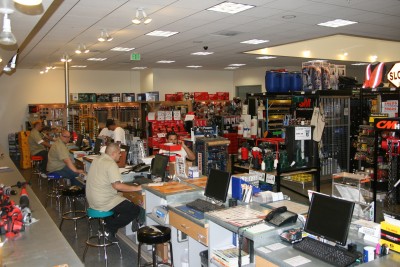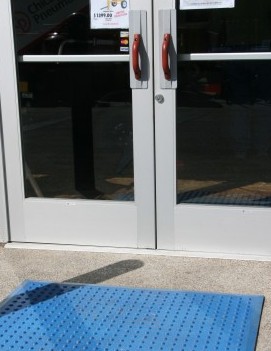Arrow: Building from the ground up
If you could build a flagship store from the ground up, how would you do it?
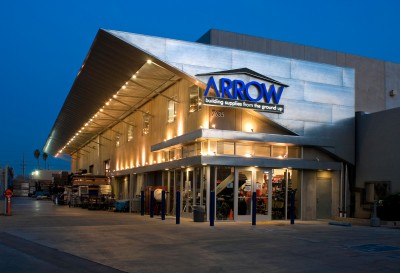
by Tom Hammel
When he first told me about Arrow Tools in Van Nuys, CA, one of my best rep friends said, “You’ve gotta see this place!” Since he has never steered us wrong, we decided to take a look.
He was right. You’ve gotta see this place.
Located one block off busy Sepulveda Blvd., between ranch houses on one side and concrete block industrial buildings on the other, Arrow’s imposing facility presents low-maintenance concrete and glass beneath a shining steel wing that stabs skyward like, well, an arrow.
After the automatic “wow” escaped my lips, the thought that followed was, “They could have built here for a lot less.” So why didn’t they?
Concept, cash and compromise
The artfully functional facility reflects the sensibilities of — and compromises between — its owners’ visions. They could have built a perfectly functional distributorship for far less, which would have been fine for one of the owners, but the other had different ideas. Big ideas. 
One way to understand the new is to look at the old. Drive around the corner (literally) and there is Arrow’s old building, which it shared with a bagel bakery, a woodworking shop and a recording studio. Parking was tight, trucks couldn’t move in and out and Arrow often had to wait to load delivery trucks until the after the other tenants had closed for the day.
So it is understandable that once they had the chance to design their own “dream home,” Arrow’s owners went maybe a tad overboard.
Or did they? This is L.A. after all. What, if anything, qualifies as overboard in this town?
Stewart Epstein, Arrow’s president, has a clear definition.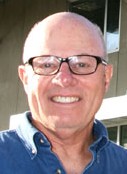 “I didn’t want to intimidate our customers,” Epstein states. “That was the balance I really wanted to strike. Even though Jeffrey wanted everything to be the way you see it around you, he was also conscious of the money it would cost. My main concern wasn’t the money, it was that balance. I would say, ‘Jeffrey, this is not a Taj Mahal. We don’t want to make the customer uncomfortable when he comes in here.
“I didn’t want to intimidate our customers,” Epstein states. “That was the balance I really wanted to strike. Even though Jeffrey wanted everything to be the way you see it around you, he was also conscious of the money it would cost. My main concern wasn’t the money, it was that balance. I would say, ‘Jeffrey, this is not a Taj Mahal. We don’t want to make the customer uncomfortable when he comes in here.
"And I think we did it right,” he adds. “People are comfortable when they come in here.”
Throughout the months of design work, Epstein and Silverman discussed this frequently. Epstein knew that a utilitarian facility would be customer-friendly and would make money, but he also appreciated Silverman’s ideas, and they fit in with his own goal for the image of the company.
Coming originally from the garment industry into distribution, he built Arrow based on business models he knew.
“One thing I learned in the apparel industry was that wherever Nordstrom went they were able to gain market share through superior service, quality and knowledge,” Epstein explains. “I felt this industry was lacking that, so I decided we would be the Nordstrom’s of the construction industry. That became my goal.”
“That was our goal from day one: to make our store a destination,” Silverman adds.
The long road to now
Epstein bought Arrow in 1990, just in time for a recession. In its first three years, Arrow went from 19 employees to 11. In those early years, Epstein would make deliveries to job sites, then switch into sales mode, often on the same site.
‘I went after small custom home builders because I didn’t have to compete with 14 other distributors for their business,” Epstein says. “I could make a reasonable profit and give them levels of service they weren’t used to getting because they were small contractors. Everyone gave the mass production builders the lowest prices because that’s what they demanded, but if you could give 10 small custom framers or concrete guys the kind of service they really deserve, you could push out the competition. That’s what we did.”
Today, as banks bulldoze unsold subdivisions less than 60 miles away, Epstein is glad he took that route.
“Custom houses, public works, commercial and multifamily are slower these days but are far from drying up,” he says. “We do a fine business in that area and it has sustained us when our competitors are off 40 to 50 percent because they relied on production builders.”
A tectonic shift
The earthquake of 1994 shook up L.A., and Arrow, too. “In 1994, I decided to move Arrow into concrete,” Epstein says. “I bought my first load of rebar that year.”
Epstein thought the spike in business from earthquake repairs would taper off, but when business continued to improve, he found himself in need of help.
In 2002, after five years of cajoling, Jeffrey Silverman, Epstein’s son-in-law, agreed to buy into Arrow. Silverman shared Epstein’s vision of superior customer service but also brought a decided flair for the artistic. One aspect of this led Silverman to explore decorative concrete finishes and chemicals, which are now a highly profitable category for Arrow.
When the time came to design and build Arrow’s “Nordstrom,” decorative concrete and other products Arrow sold would play a major role, both in and outside the building.
“We designed this place to utilize and emphasize products we sell to the industry,” Epstein says. “Jeffrey designed it because that’s his strength. Mine is looking at the bottom line, figuring the costs and determining whether it makes sense.”
The two owners also wanted a highly functional building, particularly in terms of capacity. They designed the warehouse with 34-foot ceilings to accommodate high racking systems. To maximize the number of aisles in the warehouse, they chose AisleMaster articulated forklifts, which combine tight-space maneuverability, high-lifting capability and operator safety in the same machine.
Location, location, hey, there it is!
Finding a better location close to its old one was high on Arrow’s wish list. The old Arrow was less than two blocks from the I-405, just off Sepulveda Boulevard. Land is expensive and scarce. When it does become available, usage constraints often pose an additional hurdle. But other parts of L.A. are far pricier.
“If we had wanted to build in West L.A., closer to where a lot of our materials go, this building would have cost $10 or $20 million,” Silverman explains.
To find a better location as close as possible to their old one, Arrow would have to work for it, and they did. For two years, Epstein and Silverman watched a particular parcel as its owners prepared to erect a new building. Epstein and Silverman convinced the owners to sell the land rather than build and hired that owner’s architects, who had already completed crucial studies. Arrow co-managed the construction in an owner/builder arrangement with a customer, Dirk Dayton of First
National Construction, and supplied Dayton with materials for the job.
The new building is almost entirely concrete. All through the 35,000-square-foot facility, materials were chosen, as much as possible from Arrow’s own lines, for durability and low maintenance. The exterior of the building is all “raw” concrete, galvanized steel and glass.
Arrow puts its own slogan to work and designed the building and yard literally “from the ground up” to facilitate fully loaded delivery rigs. The entire parking and yard area was poured in freeway grade concrete to facilitate truck traffic and provide a stable, safe base for the forklifts loading them. Arrow had faced years of the asphalt becoming unsafe summertime “tar pits” in their old location and would have none of that here. 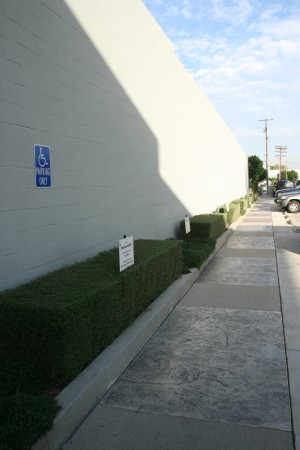
“Contractors often bring their customers here to show them the samples when they are bidding on jobs,” Silverman says. “The contractor can say to his customers, ‘Would you like to see what this will look like in your home? Come over to my supply house and see it for yourself.’ ”
Sure enough, when we returned to Arrow’s lot later that day after a job site visit, a couple was strolling the walkway, debating different designs.
Surprises around every corner
Silverman’s aesthetic influence pervades the facility’s design. When put to the challenge, Brian Sincomb, Arrow’s showroom manager, struck upon a novel way to greet customers. Instead of standard metal handles on the showroom doors, contractors are pleasantly surprised to feel the soft rubber handles of Marshalltown trowels bolted to the doors. They know they are in the right place before they even walk in.
Underfoot at each entrance, Arrow has installed Armorcast detectable warning systems. These sidewalk safety plates, manufactured just up the road in North Hollywood, are now nationally mandated by cities for use on sidewalk corners, in medians and other areas to provide pedestrians tactile and visual warnings that they are approaching a street. Naturally, Arrow sells them, too.
Just inside the doors, contractors walk across more decorative stamped floors to a service counter finished with a paint chip system Arrow sells for applications like garage floors. Just past the entrance, polished concrete leads customers down aisles of product back to the main sales counter. The counter surfaces are varnished forming plywood atop a concrete base. The entire counter area is framed by more stamped concrete work on the floor.
TV monitors mounted over the sales counter play demonstration videos nonstop. Speakers placed a few feet in front of the counter direct sound down at customers standing in line, but away from customers directly at the counter. Sales staff can comfortably converse with customers at the front of the line, while customers behind them can easily hear the videos.
The sales counter itself spans the back of the showroom and features two levels. The lower level is the sales counter. Just above and behind the floor-level sales counter, second-level work areas and offices provide a wide view of customer traffic so Arrow staff can quickly jump in to help when the counter pros are tied-up.
Nice racks
That said, Arrow doesn’t invite theft either. Most power tool inventory is kept in a tool cage in the warehouse, while selected items sit in locked racks in the showroom. A large skylight fills the showroom with natural light and provides a balcony view from administrative and sales offices on the second floor.
Silverman used the same vendor for both showroom and warehouse racking. Silverman also used the racking installation process as a training tool for Arrow staff so they could learn from beginning to end how to assemble, tear-down and relocate the systems for footprint efficiency, merchandising impact — and their own safety.
Silverman applied this “on the job training” system many times in the construction of the facility. Most of the decorative finishes in the store were applied by Arrow staff members in product training sessions.
Single store strengths
Arrow relishes its role as David vs. southern California multi-store Goliaths. Epstein believes that in the current market in particular, a well-run single store can generate good profits while avoiding the headaches of the larger staffs, facilities and fleets needed for multi-store operations.
“Jeffrey and I are very hands-on,” Epstein says, noting that both of them work the sales counter every day. “When you have multiple stores you are more removed from your customers. We still have a mom-and-pop mentality, but we can also do things that any big competitor can do as well.”
To accomplish this, Arrow has formed several alliances in critical areas to provide better service and pricing to customers. Last year, Arrow formed a partnership with an area rebar fabricator. Now Arrow can offer volume pricing that contractors could previously only get from larger multi-store competitors.
As a result, “Last year our volume of rebar grew almost 500 percent over 2007, and that was in a down market,” Epstein says.
Arrow has a similar arrangement with a firestop installation contractor. Arrow supplies the products; the contractor supplies the expert installation.
Arrow also works closely with area decorative concrete contractors, municipalities and commercial clients for products, such as the Armorcast sidewalk safety systems.
“That’s what we’ve done to overcome this market,” Epstein says. “If we had to depend on gun nail sales, we would be in real trouble, but we’ve gotten into things like firestop and Armorcast. We are going after a lot of business that we previously didn’t even know existed—and we are selling those products to our same customers, which is even better.”
Silverman firmly believes you can’t manage what you can’t measure, but he admits the difficulty of quantifying the building’s impact on Arrow’s sales. That the employees love it is obvious, but what about the customers? Will-call business, he says, has increased dramatically since 2007 when Arrow moved in here.
“And 2008 was also our best year ever — by about this much,” he says, holding up two fingers about an inch apart. “But it was our best year.”
Customer comments are uniformly glowing, local trade groups host training events at the facility, and manufacturers are amazed the first time they visit. The positive response from contractors is both gratifying and a great relief. Above all else, it tells Epstein and Silverman that they have successfully walked that line between beauty and intimidation.
Ready to grow
For a time this spring, it seemed as if multi-store distributors in southern California were imploding by the hour. 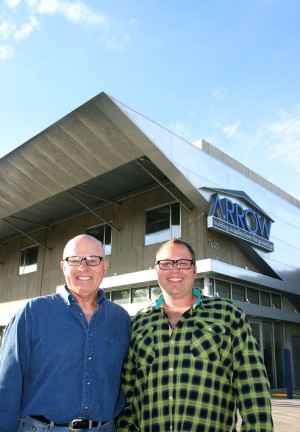 Distribution, though, is by definition entrepreneurial. Where one company collapses, another quickly moves in. Some distributors will emerge from this downturn as smaller, leaner companies. Silverman and Epstein are biding the market until they feel the time is right for Arrow to begin expanding.
Distribution, though, is by definition entrepreneurial. Where one company collapses, another quickly moves in. Some distributors will emerge from this downturn as smaller, leaner companies. Silverman and Epstein are biding the market until they feel the time is right for Arrow to begin expanding.
More Arrow branches are definitely in the offing. Thanks to their experience and training, “We have people on staff who could run three or four more stores tomorrow,” Epstein says.
When Arrow does expand, Epstein and Silverman stress the time will be right, growth will be controlled and Arrow branches will be few, well-located, lean and profitable. And you can bet that when those new branches appear, they will be darned pretty, too.







